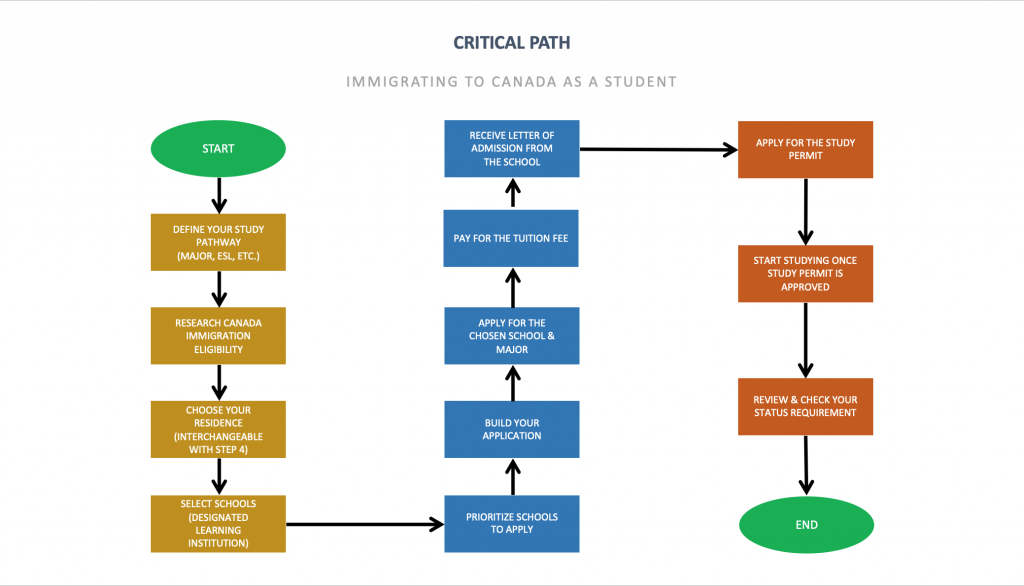
Immigrating to Canada as a Student – How Should I Prepare?
The Immigration, Refugees, and Citizenship Canada (IRCC) reports that as of December 2019, there have been a total of 642,480 international students in Canada, which ranks the country as the third country with the most international students right behind the United States of America and Australia. Many expected the number of international students to increase in year 2020, but due to the pandemic (COVID-19), this expectation has been delayed.
As there’s a strong demand from international students for starting, continuing or expanding an education in Canada, many interested candidates have been wondering how they should prepare and plan to actually study in Canada. In this blog post, we will share a general overview of what steps that you can take to immigrate to Canada as a student by acquiring a study permit.

Step 1: Define Your Study Pathway
Firstly, identify a pathway to reach your ultimate education goal. For instance, if you are targeting to complete your education within 5 years for a business accounting major, and you need to study an English as a Second Language (ESL) course to improve your English, then you can plan to take the ESL course first for 1 year and complete the business accounting course for the remaining 4 years.
Step 2: Research Canadian Immigration Regulation Eligibility
Find out if you are eligible to immigrate to Canada as a student to ensure you are not wasting any time or money. There are specific requirements that each school and/or major in Canada may require you to be eligible, so be sure to check those requirements out. To make sure, you can contact us for preliminary assessment, or any eligible immigration consultant or lawyers to find out. Moreover, you can do some extensive research by going online as well.
Step 3: Choose Your Residence (Interchangeable with Step 4)
Find out which cities and provinces of Canada you’d like to live. This may depend on the population, career expansion opportunity, income, immigration regulation, etc. You can select the best city and province that fits your needs and wants the most and focus on that area when applying for schools.
Step 4: Select Schools
You can start researching for the right schools that you’d like to apply based on the most important criteria that you are looking for. These criteria can include but not limited to, program duration, job opportunity after graduation, school reputation, tuition fee, area, transportation, proximity, class size, professors and program quality. One of the most significant aspect that we strongly recommend you to check is to find out whether the school you are applying for is a Designated Learning Institution (DLI) or not. You are only eligible to apply for a Post Graduate Work Permit upon graduation if you have studied from a Designated Learning Institution.
Step 5: Prioritize Schools to Apply
Once you have a list of schools that you are interested in, then you can prioritize which school that you are going to apply for first. You can utilize a decision-making matrix to help you prioritize based on the list of criteria that’s important to you such as a tuition fee, program quality and more.
Step 6: Build Your Application
Identify all the documents you are required to provide and prepare for them in advance. There can be some documents that may take some time for you to get due to unexpected delays, so preparing them in advance is always recommended. Build your application to ensure you are providing all information that the school is requiring you to provide.
Step 7: Apply for the Chosen School & Major
Apply for the school and program that you’ve chosen according to the school’s application steps.
Step 8: Pay for the Tuition Fee
Pay for the tuition fee that the school requires you to pay. There are many instances where you are only required to make a payment for the first semester of the program, so you may not need to pay for 100% of the tuition fee. Make sure to know the exact dates on when you can get a full refund back to ensure you can get the refund if you cannot get the study permit approval or if your plans have changed. For each school, they highly likely have a different date and may charge a non-refundable administration or processing fees, so ensure to know what you can get back and what you cannot. Moreover, it is best for you to get a confirmation from the school if you can get a full refund back (with non-refundable fees) if the study permit is disapproved just in case.
Step 9: Receive Letter of Admission from the School
Once your school application has went through successfully, the school will issue you a letter of admission. If you are applying for a major program that requires you a certain English test result, but your English skill is lacking, then you can get a conditional letter of admission that states you are qualified for the program when you finish a certain ESL course from that school.
Step 10: Apply for the Study Permit
When you have a letter of admission and a tuition fee receipt, then you can use this information to apply for your study permit. Ensure you have prepared all the required documents before you apply.
Step 11: Start Studying once Study Permit is Approved
The processing time for the study permit may vary depending on various situations, especially now when the whole process has been disrupted by the pandemic. You can start your study program once the study permit is approved.
Step 12: Review & Check Your Status Requirement
Ensure to check that your legal requirement to study in Canada are met. For students who are studying a qualified major program full-time at a Designated Learning Institution, they are allowed to work part-time (maximum 20 hours per week) on and off campus. You can build your career by working part-time as well if you are planning to get a full-time job after graduating, or you can work part-time to help pay yourself for the tuition fee. Again, if you are planning to work part-time, then make sure you are also studying full-time to meet the legal requirement.
Conclusion
Immigrating to Canada as an international student may seem very difficult and overwhelming. However, once you get to know the immigration system better, and understand what you need to prepare, then it can be a very simple and easy task. If you’d like to consult more about your specific situation further or need any help, then please contact us or submit a free assessment in our website.




